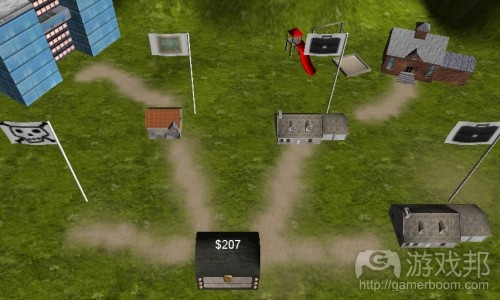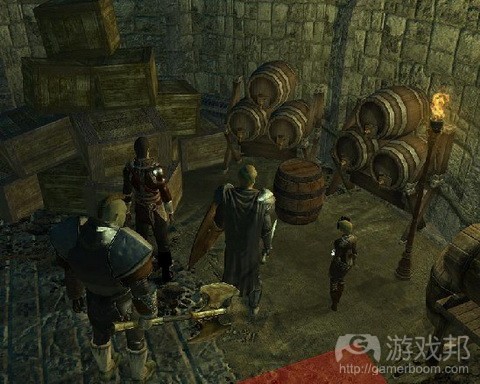关于游戏故事创作过程的几点思考
作者:Poya Manouchehri
我有个想法:人人都会在特定时刻萌生某个故事构思。我这里指的并不是真实生活的故事,而是源自想象的故事内容。
这也许是一闪而过的想法,也许是个具体的某个人,也许是篇新闻报道,也许是个真实事件,或是突然激发故事构想的游戏。而将构思转化成完整内容的过程则是个另外一个故事。
我目前正在给游戏《Connectorium》编写故事。这是我继同他人共同制作“Revival”短片后编写的第二个故事。
文章只是关于这一过程的几点随想、观察及体会。
从空想到实践
这是创意过程的普遍特性。你从空白画布着手。这个构思也许非常抽象和模糊。然后通过各个句子、若干笔画、各补充注释、或各行代码,你进一步将抽象内容具体化。
但我发现这里有个关键点:这是个双向过程。原始构思会影响你创造的内容。但你所创造的内容也会逐步对构思产生影响。最终成品也许会和原始构思大相径庭。在我看来,这是创意过程的关键要素:过程的组织性。
随着故事的逐步发展,原始构思也许会变成截然不同的内容。也许是个具体的角色,或是个特定情节点。也许是个具体设置;也许是个游戏机制。无论如何,需记住的是,你的最终故事也许会和自己的原始构想完全不同。但这并不要紧,而且可能是件好事。
回顾过去
在我初次着手《Connectorium》时,我就对故事有总体把握。游戏围绕制度和关系,所以故事主要内容是:一个小女孩某天早晨醒来后发现自己来到不同的世界,在此她丧失自己原有的所有关系网。她的探险活动主要围绕她遇见的各种角色,帮助他们恢复缺失的关系网,破解其中秘密。
但一段时间后,我停下脚步,没有将故事进一步具体化。最后我问自己,为什么要浪费时间?为什么不继续创作故事?我忽然意识到:因为我不知道故事要如何收尾。
所以某天早晨,我带着自己的iPad来到一个安静的公园,一直到想出故事要如何收尾我才返回家中。这耗费我几个小时的时间,但最终我脑中忽然闪过一个想法。这里我脸上露出会心的笑容,因为我知道现在自己可以继续编写故事。
也许这更多和我偏好编写的故事类型有关,但我发现预先把握故事结局非常重要。所有游戏情节、角色和玩法都促使读者朝此结局靠拢。这令我的故事能够保持连贯性。
角色或情节
我最欣赏的一位作家Isaac Asimov经常因融入无趣的2D角色而遭受批评。尽管如此,他依然是位非常了不起的故事叙述者。
但我们不能说,优秀故事是精彩情节和逼真角色的结合体。就个人来说,我更注重情节元素。所以我总是需要留意角色的“单调性”。
出于这点原因,在完成这一故事的初稿后,我就内容进行了修改,更多着眼于单个角色,创作更多幕后故事,修复对话和描述内容,当然还有在必要时候调整情节内容。我觉得反向操作也行得通:创建详尽的有趣角色,围绕角色发展故事内容。
对话
对我来说,故事撰写最困难部分是对话。不仅是编写出逼真、自然的2-3个角色间的流畅对话颇有难度,更难的是要让所有角色听起来各不相同,而且栩栩如生。
最重要的是,这需要时间,需要靠重写进行完善。而编写角色的幕后故事也非常重要(游戏邦注:虽然这些内容不会向读者呈现)。它们从何处来?它们做什么?它们吃什么?它们的童年是什么样子?它们呈什么关系?它们的动机是什么?所有这些都会影响角色的说话方式、反应方式及自我表达方式。
另一令我从中受益匪浅的策略是,尝试描绘扮演此角色的真人。这也许是你认识的某个人,或是个演员。将外观和声音同对话进行搭配能够有效帮你查看内容是否匹配。有时以预期的角色声音大声读出对话也会令你从中有所收获。
游戏主题
关于故事元素,我已谈论很多,但在游戏方面涉猎的并不多。这里我要阐述自己的一个观点,也许有人会持不同看法。
我觉得玩法必须最大限度地强化故事内容。至少不能够同故事相抵触,因为这会促使你丧失游戏的沉浸性。你多常在游戏中东奔西跑,消灭各种不同元素,收集各种不同道具、数据,而这仅仅是因为游戏过场动画提醒你,你其实是在解决一个更大的冲突。
这里我要阐述另一个观点。故事模式多种多样,为什么很多故事,尤其是那些包含情节和角色元素的故事会将战斗设置成自己的核心机制?
我们是不是刻意回避未将战斗当作主要元素的故事内容?或者我们倾向在混合内容中植入战斗元素,无论它是否强化故事内容?(本文为游戏邦/gamerboom.com编译,拒绝任何不保留版权的转载,如需转载请联系:游戏邦)
Opinion: Once upon a time…
by Poya Manouchehri
[In this reprinted #altdevblogaday opinion piece, former Microsoft software design engineer Poya Manouchehri shares some advice for writing the story of your game.]
I have a theory: everyone has or will have, at some point, an idea for a story they want to write. Or tell. And I don’t mean a real life story, but a story that is a creation of one’s imagination.
Now it might be a passing thought… Maybe it’s a person, a news report, a real life event, a book, or a game that suddenly triggers an idea for a story. The process of turning that idea into something complete and finished is a whole other…well, story.
Currently I’m writing the story for the game Connectorium. It’ll be the second story I’m writing in full, after co-writing the Revival short film (I’m not counting the one or two short stories here and there, and a failed attempt at writing a fantasy novel after watching the first Lord of the Rings film. Who didn’t do that, right?).
Here are just a collection of random thoughts, observations, and experiences about the process. Obviously these are not the opinions of an expert; I’m merely hoping it opens up the way for a conversation and invites thoughts from you.
From abstraction to realization
This is something that is universal to the creative process. You begin with an empty canvas. Maybe a concept that is completely abstract and vague. Then with every sentence, with every stroke of a brush, with every added note, or with every line of code, you bring that abstraction one step closer to existence (and also the number of possibilities of what that end product will be reduces with every step).
But there is a key thing I have realized: this is a tw- way process. The original idea, or concept affects what you create. But what you create also affects the idea over time. To a point where the final product may in no way resemble the original idea. I think this a very important part of the creative process: the organic nature of it.
As far as a story goes, that initial concept and idea can be many different things. Maybe it’s a particular character, or a specific plot point. Maybe it’s a particular setting. Maybe it’s a mechanic in the game you are designing. Either way, it’s important to keep in mind that your completed story may be nothing like what you had initially conceived. And that’s OK. In fact it’s more than OK. It’s usually a good thing.
Working backwards
When I first started working on Connectorium, I had a general idea for the story. The game is about systems and connections, so the story was going to be about a little girl who wakes up one morning to a world where all connections have gone missing. Her adventure would be about her meeting various characters, helping them restore the missing connections, and solving the mystery.
For some time, though, I stalled fleshing out the story more. Eventually I asked myself, why am I wasting time? Why don’t I just write the story? And it occurred to me: it’s because I didn’t know how it’s going to end.
So one morning I decided to take my iPad, go to a quiet park, and not come back home until I figured out how the story will end. It took a couple of hours, but eventually I came up with an idea, quite suddenly really. I had a big smile on my face right at that moment, because I knew I could start writing the story now.
Maybe this is more a function of the kinds of story that I enjoy and like to write, but I find that I really need to know the ending early on. Everything in the plot, the characters, and the gameplay in the case of a game, is pushing the audience towards that ending. It’s what keeps the story coherent to me.
Characters or plot
One of my favorite writers, Isaac Asimov, is often criticized for having somewhat uninteresting and 2D characters. Nevertheless he is an amazing story teller.
But one can’t argue that the best of stories combine a great plot with believable and great characters. What I have noticed is that personally I’m much more interested and focused on the plot. So I always need to be conscious of the “flatness” of my characters.
For that reason, after I have written the initial draft of the story, I’ll do an iteration where I’ll focus specifically on each character, writing more back story, fixing the dialogue, descriptions, and so on, of course adjusting the plot where necessary. I can imagine the reverse can work just as well: building a detailed and interesting character, and developing the story around that character (or characters).
Dialogue, dialogue, dialogue
For me, probably the hardest part of writing a story is the dialogue. Not only is it really hard to write a believable, natural, and flowing conversation between two or more characters, it’s even harder to have all your characters not sound exactly the same! Exactly like…you!
More than anything, it just requires time, and rewrites to improve this. It is also important to have back stories for characters, even if none of it is ever revealed to the audience. Where do they come from? What do they do? What do they eat? What was their childhood like? What are their relationships like? What is their motivation? All of these impact how a character speaks, how they would react to a situation, and how they’d express themselves.
Another thing that has helped me is trying to picture a real life person acting out that character. Maybe someone you know, or an actor. Putting a face and voice to a line of dialog goes a long way to help you see if it’s the right fit. Sometimes reading it out loud in the voice that you think the character would be speaking in also helps here.
On the subject of games
I’ve been talking a lot about stories, and haven’t really talked much about games. Here is point I want to make which I can expect at least some to disagree with.
I feel that the gameplay must reinforce the story as much as possible. At the very least it shouldn’t contradict it, because that takes you out of the immersion that you might otherwise have. How often do you run around in a game, killing various things, and collecting numerous items, stats, etc, just to be reminded by a cutscene that you’re actually trying to resolve a much greater conflict.
And here is another (potentially less popular) thought. Given that there are practically infinite possible stories, why is it that a good percentage of games, especially those with plots and characters, include combat in some form as their core mechanic?
Is it that we are simply avoiding stories where combat isn’t an integral component? Or are we throwing in combat into the mix, regardless of whether or not it reinforces the story?(Source:gamasutra)










































 闽公网安备35020302001549号
闽公网安备35020302001549号